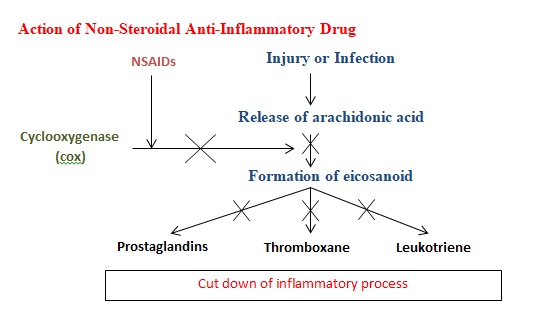Non-steroidal Anti-inflammatory drugs
Contents
- Introduction
- Physiology of inflammatory mediators
- Mechanism of action
- classification
- Plasma half-life
- Adverse effects
Introduction
NSAIDs are a class of medications most often prescribed in treatment of inflammation, pain and fever. Physiotherapist might have come across these drugs during rehabilitation period. In pharmacodynamic aspect,NSAIDs inhibits cyclo-oxygenase enzyme. Cyclo-oxygenase enzymes are necessory for producing prostaglandins during inflammatory processes. NSAIDs are known for multiple adverse effects, especially in elders.
Pathophysiology of inflammatory mediators
Arachidonic acid
These are polyunsaturated fatty acids present in liver, brain and muscles. It is released during injury or infection and oxygenated by enzymes (cyclo-oxygenase) to produce inflammatory mediators called eicosanoids (prostaglandins, thrombaxane and leukotrines).
cyclo-oxygenase (cox-1)
- It plays major role in protection of gastric mucosa through vasodilatation, stimulation of mucus and bicarbonate (which produces barrier for acid injury).
- Production of prostaglandins in kidney which in turn causes vasodilatory effects.
- It also stimulates thrombaxane which causes platelet aggregation.
Cyclo-oxygenase (cox-2)
- Cox-2 is produced in inflammatory cells. cox-2 stimulates prostaglandins in injured tissues lead to vasodilation and heat production.
- cox-2 inhibition is the desired effect of NSAIDs' anti-inflammatory, analgesic and antipyretic response.
Prostaglandins
- Prostaglandins are produced at the sites of injury and infection. it has vasodilatory effects, which causes swelling.
- It also produces fever during infection by stimulating hypothalamus.
Thrombaxane
- It is one of the metabolite of arachidonic acid, which produces platelet aggregation during inflammation.
Mechanism of action

Classification of NSAIDs
Non selective Cox inhibitors
Non selective drugs inhibit both cox-1 and cox-2. Because of this, there may be side effect of gastric ulcer. So, these drugs are prescribed with gastro protective drugs (e.g. pantaprazole) to avoid side effects.
Following are the non-selective cox inhibiting drugs:Irreversible (cox1 > cox2)
- Aspirin
- Sod salicylate
- Olsalazine
- Methyl salicylate
Reversible (cox1=cox2)
- Indomethacin
- Sulindac
- Ibuprofen
- Ketoprofen
- Naproxen
- Mefenamic acid
- Ketorolac
- Aceclofenac
- Diclofenac
- Piroxicam
- Tenoxicam
Selective cox-2 inhibitor
These drugs specifically inhibit cox-2 enzymes.
- Celecoxib
- Rofecoxib
- Valdecoxib However, rofecoxib and valdecoxib were withdrawn from the market in 2004 and 2005, respectively.
Plasma half life
Plasma halflife of NSAIDs ranges from 0.25 to >70 hours. For example, diclofenac sodium has half life of 1.15 hour.
Adverse effects
- Gastrointestinal complications
- Cardiovascular events
- Renal toxicity
- Exacerbation of hypertension
- Fluid retension
SHARE:


- Supakanya wongrakpanich, amaraporn wongrakpanich, janani rangaswami., A comprehensive review of Non-steroidal anti-inflammatory drug use in elderly (2018).
- Ida Ghlichloo; Valerie Gerriets., Non-steroidal anti-inflammatory drugs (2021).→
- S. Bacchi, P. Palumbo, A. Sponta and M.F. Coppolino., Clinical Pharmacology of Non-Steroidal Anti-Inflammatory Drugs: A Review (2012).
| Name | : | Deva senathipathi |
| Qualifications | : | Physiotherapist |





